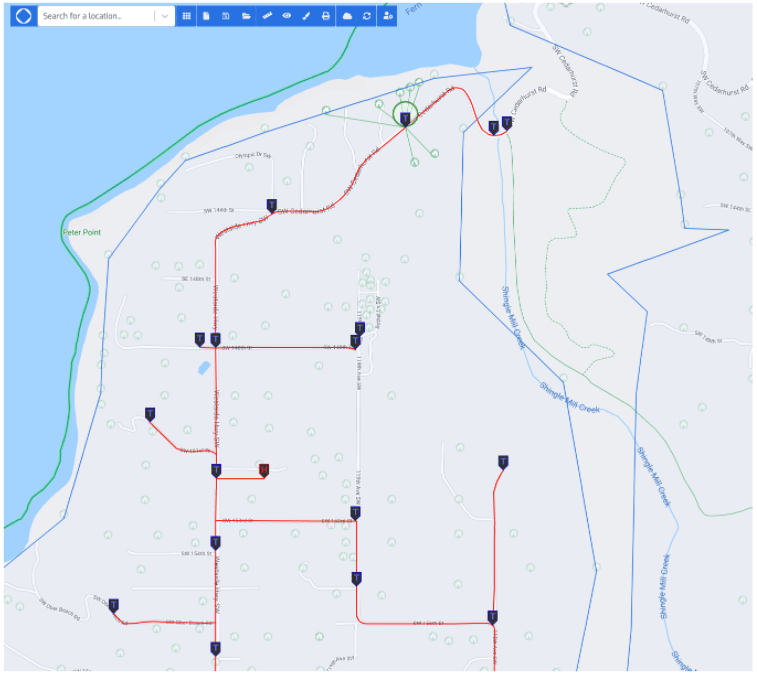PROJECTS
Arrow by Altman Solon Streamlines Fiber Provider’s Engineering Design Processes
Arrow by Altman Solon enables a fiber provider to automate the engineering design phases, greatly improving the accuracy of each step while reducing the time and cost to complete.
Arrow by Altman Solon’s proprietary network planning platform, empowers clients to implement fixed and wireless broadband network deployment strategies, improving financial returns by more than 50%.
Challenge
Broadband service providers are racing for their share of the market. At the same time, legacy telcos, cable operators, fiber players, and in some parts of the world even fixed wireless providers, and near-earth satellite network operators are competing for customers. In such a competitive market, decision speed is critical when making an expansion plan. Furthermore, deploying fiber to the home, enterprise, or tower is a capital-intensive process, so it is imperative to create accurate initial designs to support each business case underpinning an expansion plan.
Altman Solon’s client, a large fiber provider, was facing three challenges in their fiber network engineering design process:
- Speed–It took the network engineering firm four to six weeks to develop an initial design for a city-wide build.
- Cost– By outsourcing the initial design, each costs nearly $40k.
- Accuracy– Due to human error, fiber mileage in the design could be miscalculated by up to 25%, putting the expansion business case in jeopardy.
Their legacy methodology consisted of two phases. In phase one of a city-wide design, the outsourced engineering firm would leverage a GIS tool to draw the high-level design of a possible route by hand, which often took one to two weeks and required client approval. In phase two, the engineering firm would drive every mile of the route to ensure the paths existed, correct for errors in the high-level design, and produce a more detailed set of routes. This phase would typically take three to four weeks.
Solution
The client adopted Arrow by Altman Solon as their primary approach to fiber network planning. With the implementation of Arrow, network planners could plan a scenario and run it within minutes.
Such a scenario included:
- Targeted locations (e.g., homes, businesses, towers) in a polygon area
- Competitive providers, including broadband service speeds offered and brand strength
- Existing equipment (e.g., splice points) that could be leveraged for the route
- Detailed cost assumptions for equipment and fiber labor rates (e.g., aerial vs. underground)
- Detailed revenue assumptions, including subscriber ARPU, growth, and churn
Each scenario produced a business case for the target area and an initial fiber network plan design. Using Arrow by Altman Solon, network planning engineers would then iterate through several scenarios, including different location types to target (e.g., include or exclude multi-dwelling units), coverage goals (e.g., 80% vs. 90% of premises covered), and CapEx budget.
Once the initial design and accompanying business case were developed, Arrow enabled enhanced editing functionality, combining the high-level automated design with a human-assisted detailed design. The detailed design included changing the exact placement of equipment (e.g., Fiber Distribution Hub or Terminal), re-assigning household locations to Hubs or Terminals, re-routing feeder and distribution fiber based on better knowledge of local right of ways or permit availability, and annotating elements of the design to streamline the hand-off to construction engineering.

Once the editing was complete, the design was automatically synced up with Arrow by Altman Solon’s financial and geospatial summary reports, including locations covered, plan routes, and the detailed financial business case. In a scenario where changing the feeder fiber route increases the cost of the business plan, the net present value will be updated to reflect the change. The detailed design can also be viewed in the Arrow user interface, allowing for approval inside the application.

Results
Leveraging Arrow by Altman Solon, the team was able to automate a significant portion of the fiber network planning expansion and design process. The time to produce an accurate and detailed design was decreased from upwards of six weeks down to minutes. By no longer having to outsource this critical step, the cost of producing the design was eliminated. The platform also lowered the expected error rate of build mileage from ~25% to less than 5%.
The figure below shows the engineering route developed by the third-party engineering firm versus the design developed by the Arrow by Altman Solon platform, along with the key drivers for the mileage differences. In one market where outsourced engineering design was compared to the platform design, the outsourced design was overestimating mileage by 15%, which would cost the fiber provider an additional $3.5M to cover the same sets of locations.

Perhaps most importantly, the iterations enabled with Arrow by Altman Solon’s optimization speed and integrated business and engineering planning platform empower fiber providers to be more strategic in their network expansion and deployment plans – reaching their target markets, improving accuracy at each step, and minimizing time and cost to complete.